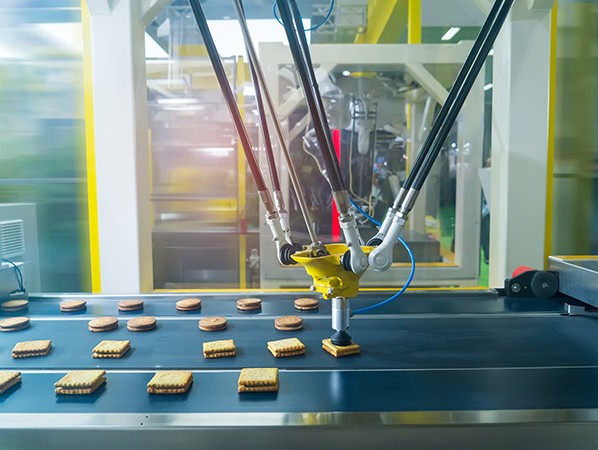
'An increased deployment of robots and data technology makes the food industry safer, more attractive, and more competitive', says the ING report 'Foodtech: Technology in the food industry'. Ceel Elemans, Sector Banker Food & Agri explains some of the findings.
Which technologies are important for the sector's future? What are the main driving forces to apply them, and what does 'Foodtech' mean for the competitive position and employment in the industry? The ING Economics Desk conducted a study and presented its results in the report called 'Foodtech: Technology in the food industry'.
Ceel Elemans: "Food producers in the Netherlands annually spend 350 million Euros on R&D and invest 1.4 billion Euros in machines and digitisation. New technological applications allow companies to stay competitive in an international playing field. Furthermore, they help to meet the changing demands of clients, consumers, and society. Foodtech includes all technological applications used in the food industry. Innovations in robotics, data technology, and processing techniques create new application opportunities. The study shows in a well-substantiated manner that Foodtech serves multiple purposes. Investing in Foodtech is the competitive edge for the Dutch food industry. The return is substantial: more, better, and safer food products; strengthening of the competitiveness; a better balance for the consumer and society when it comes to responding to changing demands; more attractive employer practices, and a noticeable contribution to an increased labour productivity in order to facilitate the necessary growth within the sector. This will safeguard the continuity of food production in the Netherlands".
"No messing with our food. The consumer wants to be more and more informed about the foodstuffs they eat and they want transparency about the provenance. We are all sick and tired of scandals such as selling horse meat as beef. We want transparency from farmer to plate. One of the data technology applications to improve the traceability of products throughout the chain is the Radio Frequency Identification chip (RFID): a wireless chip with the size of a grain of rice. Such a chip can be used to track a certain product throughout the chain. This technology makes it possible to guarantee antibiotic-free meat within the chain or the Better Life quality label."
Via QR codes, the consumer can also easily find all the information about the composition, provenance, and the production of food. This solves the problem of the limitations that labels have. At Albert Heijn supermarkets, customers can already retrace the route of their bottle of orange juice, for example, to every small detail from production until their shopping cart. The supermarket chain has taken the first step to meet the increased customer demand regarding transparency about products so they can get insight into how they were produced. You can scan the QR code on a package and subsequently see where the oranges have been from the moment they were picked in Brazil, and how the various involved parties such as growers score on aspects like sustainability and food safety. The information also includes data on the period in which the fruit was picked and on its acidity."
"Every innovation starts on a small scale; someone was the first to try something. We will always need pioneers who can see the dot on the horizon. As soon as such an innovation is visible and profitable, it will be embraced in a much wider scope: a kind of 'conga line' principle. With regard to robotisation in the food industry, we now know that it can guarantee a continuous and increased productions process. One in four companies now uses robotics and/or big data analyses. For the other companies, there is still a lot they can do. Even so, steps must be made because – as Einstein said – 'If you do the same thing over and over again, you cannot expect progress'."

"To give a few examples of processing technologies: High Pressure Processing (HPP): this technology is used for the pasteurisation and sterilisation of products. For pasteurisation, the technology is already commercially obtainable and applied, for sterilisation, it is still in development. HPP is, amongst other things, used for the production of juices, cold meat products, ready meals, and spreads. The High Pressure Processing extends the shelf life of freshly processed products and it brings new export markets within reach. This technology is an immediate answer to the consumer demand for fresh and healthy products that are free of chemical additives.
Pulsed Electric Field is an alternative for the pasteurisation of liquid foods such as juices and soups, and it is also used in the processing of potatoes. As the resources can be processed at a low temperature, the nutrients are maintained better and the production is more energy-efficient.
3D-food printing can become a very promising innovative development. It clearly is still a niche, but looking at the many developments, 3D-food printing is slowly becoming more and more promising. A company from Rotterdam recently presented a worldwide first with edible filling for the 3D-Food Printer. The cartridge is filled with only fresh, natural ingredients such as beetroot purée. The tastes are tested and further developed in collaboration with Jan Smink, owner of Restaurant Smink and formerly working at the three-Michelin-star restaurant De Librije in Zwolle."
"Robots can do more than just stacking boxes and, within the food industry, they are used for various purposes: generic robots for heavy, standardised work activities such as sorting boxes or the storage of pallets while more specialised robots can carry out more complex and specific tasks. Examples are a carcass opener in the meat industry, coring robots for lettuce and peppers for the processing of vegetables, and packing robots for biscuits and sweets. Because food products are vulnerable and usually come in more different shapes and sizes than, for example, car parts, the food industry is always about customisation and precision. One wrong setting and the toast will be broken before it reaches the end of the production line, and that is not what you want."
"Large food producers are looking for ways to respond to the 'high-touch need' with at least part of their brands or product range. Bread producers, for instance, invest in artisanal production lines and large beer brewers respond to the craft beer trend, which they do by taking over or facilitating smaller brewers This often results in a middle ground: production within large enterprises linked to a more small-scale brand and ditto marketing."
"There are around 150,000 people working in the Dutch food, beverages and tobacco industry. Partly because of the high share of production jobs, a relatively large part of the overall employment will be affected by automation. This is why new technologies will not just have an impact on the future amount of work in the sector, they also affect the nature of the work. The kind of work is shifting. With Foodtech, the complexity of productions processes also increases and this requires an upgrading of the existing jobs. While the packaging and warehouse activities are automated, the demand for product developers, engineers, and data analysts rises. Until 2030, just the outflow as a result of employees reaching the retirement age alone is estimated at around 40,000 employees. So there is a lot of work to be done. The deployment of new technology will further increase the labour productivity in the sector and, thereby, contribute significantly as to how the need for personnel within the sector must be organised by the time we find ourselves in 2030. Robotisation can help to prevent a shortage of staff. It increases the profitability of the companies and helps them to ease strenuous production work. This way, the robot literally gives a helping hand."
Read the full report here (Dutch only)
Picture Ceel: ©Jasper Lensselink, picture robot: ©Asharkyu/Shutterstock.com
Source: © Vakblad Voedingsindustrie 2019